Thoroughly analyzing AP Inter 2nd Year Maths 2A Model Papers and AP Inter 2nd Year Maths 2A Question Paper May 2018 helps students identify their strengths and weaknesses.
AP Inter 2nd Year Maths 2A Question Paper May 2018
Time: 3 Hours
Maximum Marks: 75
Note: This question paper consists of THREE sections A, B, and C.
Section – A
(10 × 2 = 20 Marks)
I. Very Short Answer Type Questions.
- Answer ALL questions.
- Each question carries TWO marks.
Question 1.
If Arg z1 and Arg z2 are \(\frac{\pi}{5}\) and \(\frac{\pi}{3}\) respectively, then find (Arg z1 + Arg z2).
Solution:
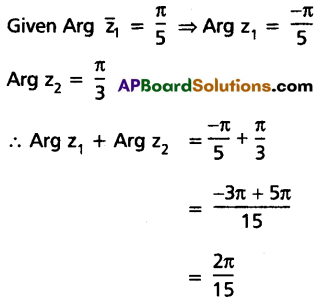
Question 2.
Find the square root of 7 + 24i.
Solution:
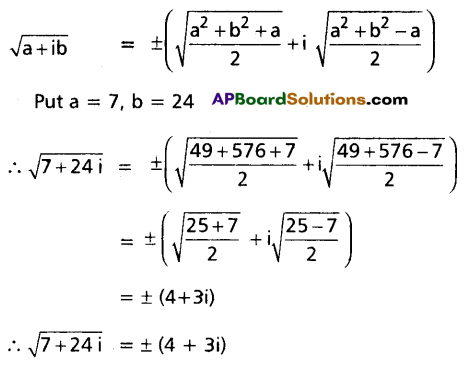
Question 3.
Find the value of (1 – i)8.
Solution:
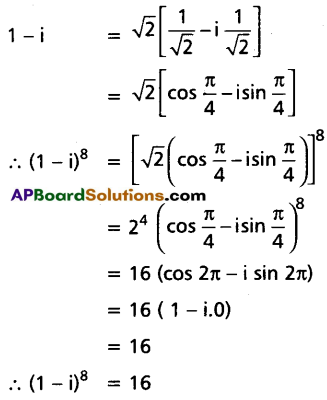
Question 4.
For what values of x, the expression x2 – 5x + 6 is positive?
Solution:
x2 + 5x + 6 > 0
⇒ x2 – 2x – 3x + 6 > 0
⇒ x (x – 2) – 3 (x – 2) > 0
⇒ (x – 2) (x – 3) > 0
⇒ x < 2 (or) x > 3
⇒ x ∈ (-∞, 2) ∪ (3, ∞)
![]()
Question 5.
If 1, 1, α are the roots of x3 – 6x2 + 9x – 4 = 0, then find α.
Solution:
Since 1, 1, α are the roots of x3 – 6x2 + 9x – 4 = 0
S1 = \(\frac{-(-6)}{1}\)
⇒ 1 + 1 + α = 6
⇒ α = 4
Question 6.
Find the number of ways of arranging 5 boys and 4 girls in a row, so that the row begins with a boy and ends with a girl.
Solution:
No. of boys = 5
No. of girls = 4
For the required arrangement, the first place can be filled with boys which can be done in 5 ways, the last place can be filled with girls it can be in 4 ways, the remaining 7 places can be filled with remaining boys and girls it can be done in 7! ways.
∴ The no. of required arrangements = 5.4.7!
= 20(5040)
= 100800
Question 7.
Find the number of diagonals of a polygon with 12 sides.
Solution:
The no. of diagonals of a polygon with n sides = \(\frac{n(n-3)}{2}\)
The no. of diagonals of a polygon with 12 sides = \(\frac{12(12-3)}{2}\) = 54
Question 8.
Find the middle term in the expansion of \(\left(\frac{3 x}{7}-2 y\right)^{10}\).
Solution:
The no. of terms in the expansion of \(\left(\frac{3 x}{7}-2 y\right)^{10}\) is 11
∴ 6th term is the middle term.
∴ T6 = T5+1
= \(1_{C_5}\left(\frac{3 x}{7}\right)^{10-5}(-2 y)^5\)
= \({ }^{10} C_5 \cdot \frac{3^5}{7^5} \cdot x^5 \cdot(-2)^5 y^5\)
= \(-10_{C_5} \cdot \frac{6^5}{7^5} \cdot x^5 \cdot y^5\)
Question 9.
Compute the mean deviation about the median for the data 6, 7, 10, 12, 13, 4, 12, 16.
Solution:
Given data points are 6, 7, 10, 12, 13, 4, 12, 16
Expressing the data points in the ascending order of the magnitude 4, 6, 7, 10, 12, 12, 13, 16
∴ Median = \(\frac{10+12}{2}\) = 11
The absolute values are |11 – 4|, |11 – 6|, |11 – 7|, |11 – 10|, |11 – 12|, |11 – 12|, |11 – 13|, |11 – 16| = 7, 5, 4, 1,1, 1,2, 5
∴ Mean deviation about medium = \(\frac{7+5+4+1+1+1+2+5}{8}\) = 3.25
![]()
Question 10.
Let X be a random variable such that
P(X = -2) = P(X = -1) = P(X = 2) = P(X = 1) = \(\frac{1}{6}\) and P(X = 0) = \(\frac{1}{3}\); then find the mean of X.
Solution:
Given P(X = -2) = P(X = -1) = P(X = 2) = P(X = 1) = \(\frac{1}{6}\) and P(X = 0) = \(\frac{1}{3}\)
∴ Range of a random variable X = {-2, -1, 0, 1, 2}
∴ Mean of X = (-2) P(X = -2) + (-1) P(X = -1) + (0) P(X = 0) + (1) P(X = 1) + (2) P(X = 2)
= \((-2) \frac{1}{6}+(-1)\left(\frac{1}{6}\right)+0\left(\frac{1}{3}\right)+1\left(\frac{1}{6}\right)+2\left(\frac{1}{6}\right)\)
= \(\frac{-2}{6}-\frac{1}{6}+0+\frac{1}{6}+\frac{2}{6}\)
= 0
Section – B
(5 × 4 = 20 Marks)
II. Short Answer Type Questions.
- Answer ANY FIVE questions.
- Each question carries FOUR marks.
Question 11.
Determine the locus of z, z ≠ 2i such that Re\(\left(\frac{z-4}{z-2 i}\right)\) = 0.
Solution:
Let z = x + iy
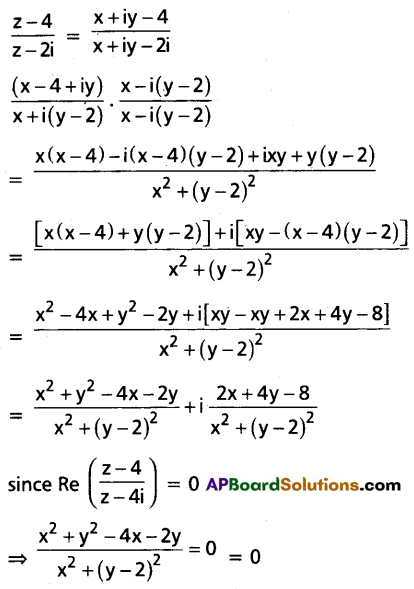
⇒ x2 + y2 – 4x – 2y = 0
∴ The locus of Z is x2 + y2 – 4x – 2y = 0
Question 12.
Find the maximum value of the function \(\frac{x^2+14 x+9}{x^2+2 x+3}\) over R.
Solution:
Let y = \(\frac{x^2+14 x+9}{x^2+2 x+3}\)
⇒ yx2 + 2xy + 3y = x2 + 14x + 9
⇒ (1 – y)x2 + (14 – 2y)x + (9 – 3y) = 0
x ∈ R ⇒ (14 – 2y)2 – 4(1 – y)(9 – 3y) ≥ 0
⇒ 4(7 – y)2 – 4(1 – y)(9 – 3y) ≥ 0
⇒ (7 – y)2 – (1 – y)(9 – 3y) ≥ 0
⇒ 49 – 14y + y2 – (9 – 3y – 9y + 3y2) ≥ 0
⇒ 49 – 14y + y2 – 9 + 12y – 3y2 ≥ 0
⇒ -2y2 – 2y + 40 ≥ 0
⇒ 2y2 + 2y – 40 ≤ 0
⇒ y2 + y – 20 ≤ 0
⇒ (y + 5)(y – 4) ≤ 0
⇒ -5 ≤ y ≤ 4
Maximum value = 4, Minimum value = -5
Question 13.
If the letters of the word EAMCET are permuted in all possible ways and if the words thus formed are arranged in the dictionary order, then find the rank of the word EAMCET.
Solution:
The dictionary order of the letters of the word EAMCET is A, C, E, E, M, T
In dictionary order the words which begin with the letter A come from first.
If we fill the first place with A remaining 5 letters can be arranged in \(\frac{5 !}{2 !}\)
A – – – – – = \(\frac{5 !}{2 !}=\frac{120}{2}\) = 60
C – – – – – = \(\frac{5 !}{2 !}=\frac{120}{2}\) = 60
E A C – – – = 3! = 6
E A E – – – = 3! = 6
The next word is EAMCET = 1
Hence the rank of the word EAMCET is 60 + 60 + 6 + 6 + 1 = 133
Question 14.
Find the number of ways of selecting an 11-member cricket team from 7 batsmen, 6 bowlers, and 2 wicket-keepers so that the team contains 2 wicket-keepers and atleast 4 bowlers.
Solution:
The required cricket team can have the following compositions:
| Bowlers | Wicket keepers | Batsman | No. of Ways of Selecting Team |
| 4 | 2 | 5 | 6C4 × 2C2 × 7C5 = 15 × 1 × 21 = 315 |
| 5 | 2 | 4 | 6C5 × 2C2 × 7C4 = 6 × 1 × 35 = 210 |
| 6 | 2 | 3 | 6C6 × 2C2 × 7C3 = 1 × 1 × 35 = 35 |
∴ The No.of ways of selecting the team containing 2 wicket keepers and atleast 4 bowlers = 315 + 210 + 35 = 560
![]()
Question 15.
Resolve \(\frac{2 x^2+1}{x^3-1}\) into partial fractions.
Solution:
x3 – 1 = (x – 1) (x2 + x + 1)
Let \(\frac{2 x^2+1}{x^3-1}=\frac{A}{x-1}+\frac{B x+c}{x^2+x+1}\) = \(\frac{A\left(x^2+x+1\right)+(B x+C)(x-1)}{(x-1)\left(x^2+x+1\right)}\)
⇒ 2x2 + 1 = A(x2 + x + 1) + (Bx + C) (x – 1) ………(1)
Put x = 1
2 + 1 = A(1 + 1 + 1)
⇒ 3 = 3A
⇒ A = 1
Equating the Coefficient of x2 terms on both sides, in (1)
2 = A + B
⇒ 2 = 1 + B
⇒ B = 1
Comparing constant terms on both sides, in (1)
1 = A – C
⇒ 1 = 1 – C
⇒ C = 0
∴ \(\frac{2 x^2+1}{x^3-1}=\frac{1}{x-1}+\frac{x}{x^2+x+1}\)
Question 16.
Two persons A and B are rolling a dice on the condition that the person who gets 3, will win the game. If A starts the game, then find the probabilities of A and B respectively to win the game.
Solution:
p = Probability of getting 3 = \(\frac{1}{6}\)
q = 1 – p
= 1 – \(\frac{1}{6}\)
= \(\frac{5}{6}\)
Probability of success (p) = \(\frac{1}{6}\)
Probability of failure (q) = \(\frac{5}{6}\)
A may win the game either in the first trial (or) third trial (or) fifth trial (or) etc.,
∴ Probability of A win the game = p + q q p + q q q q p + ……..
= p(1 + q2 + q4 + …….)
= \(p\left(\frac{1}{1-q^2}\right)\)
= \(\frac{1}{6}\left(\frac{1}{1-q^2}\right)\)
= \(\frac{1}{6}\left(\frac{1}{1-\frac{25}{36}}\right)\)
= \(\frac{6}{11}\)
∴ Probability of B win the game = 1 – \(\frac{6}{11}\) = \(\frac{5}{11}\)
Question 17.
If A and B are two events with P(A ∪ B) = 0.65, P(A ∩ B) = 0.15, then find the value of P(AC) + (BC).
Solution:
Given P (A ∪ B) = 0.65, P (A ∩ B) = 0.15
∴ P(\(\bar{A}\)) + P(\(\bar{B}\)) = 1 – P(A) + 1 – P(B)
= 2 – [P(A) + P(B)]
= 2 – [P(A ∪ B) + P(A ∩ B)]
= 2 – [0.65 + 0.15]
= 2 – 0.8
= 1.2
Section – C
(5 × 7 = 35 Marks)
III. Long Answer Type Questions.
- Answer ANY FIVE questions.
- Each question carries SEVEN marks.
Question 18.
Show that one of the values of \(\left(\frac{1+\sin \frac{\pi}{8}+i \cos \frac{\pi}{8}}{1+\sin \frac{\pi}{8}-i \cos \frac{\pi}{8}}\right)^{\frac{8}{3}}\) is -1.
Solution:
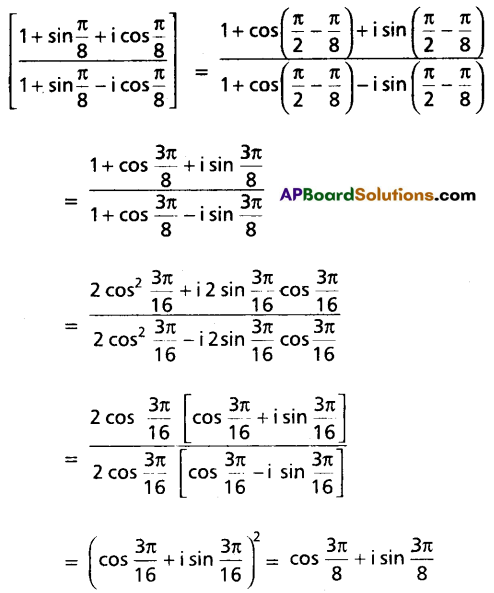
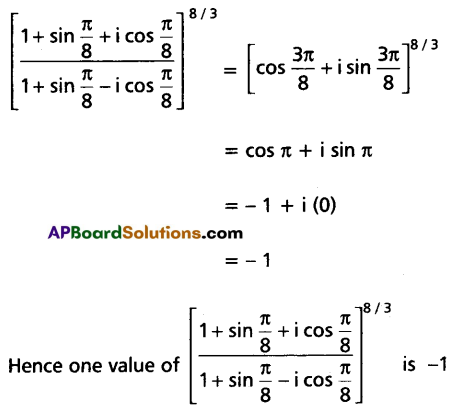
Question 19.
Solve the equation x4 – 10x3 + 26x2 – 10x + 1 = 0.
Solution:
Given x4 – 10x3 + 26x2 – 10x + 1 = 0
⇒ x2 – 10x + 26 – 10 . \(\frac{1}{x}+\frac{1}{x^2}\) = 0
⇒ \(\left(x^2+\frac{1}{x^2}\right)-10\left(x+\frac{1}{x}\right)\) + 26 = 0
Let x + \(\frac{1}{x}\) = a Then \(x^2+\frac{1}{x^2}\) = a2 – 2
Substituting these values in (1)
(a2 – 2) – 10a + 26 =
⇒ a2 – 2 – 10a + 26 = 0
⇒ a2 – 10a + 24 = 0
⇒ (a – 4) (a – 6) = 0
⇒ a = 4 (or) a = 6
∴ a = 4
x + \(\frac{1}{x}\) = 4
⇒ x2 + 1 = 4x
⇒ x2 – 4x + 1 = 0
⇒ x = \(\frac{4 \pm \sqrt{16-4.1 .1}}{2.1}\)
⇒ x = \(\frac{4 \pm 2 \sqrt{3}}{2}\)
⇒ x = 2 ± √3
∴ a = 6
⇒ x + \(\frac{1}{x}\) = 6
⇒ x2 + 1 = 6x
⇒ x2 – 6x + 1 = 0
⇒ x = \(\frac{6 \pm \sqrt{36-4.1 .1}}{2.1}\)
⇒ x = \(\frac{6 \pm 4 \sqrt{2}}{2}\)
⇒ x = 3 ± 2√2
∴ The roots are 2 ± √3, ± 2√2
![]()
Question 20.
Prove that \(C_0+\frac{3}{2} \cdot C_1+\frac{9}{3} \cdot C_2+\frac{27}{4} \cdot C_3+\ldots \ldots+\frac{3^n}{n+1} \cdot C_n=\frac{4^{n+1}-1}{3(n+1)}\)
Solution:
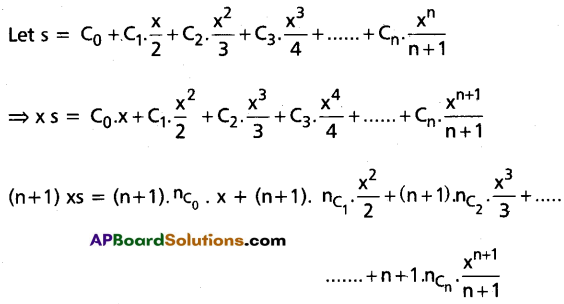
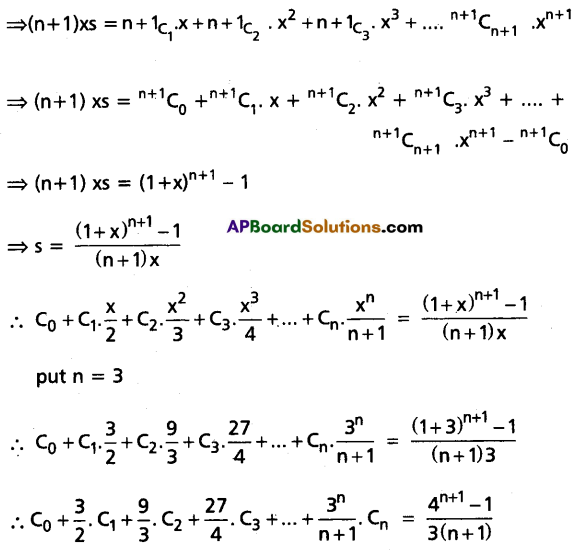
Question 21.
If \(\frac{1}{5}+\frac{1.3}{5.10}+\frac{1.3 .5}{5 \cdot 10.15}\) + ……… ∞, then find 3x2 + 6x.
Solution:
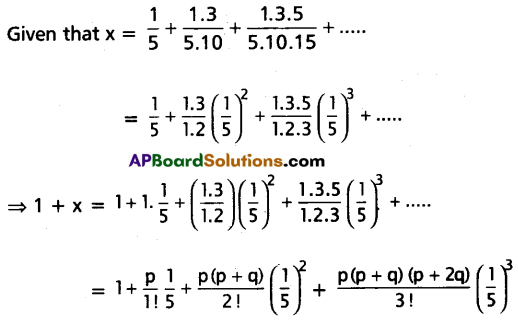
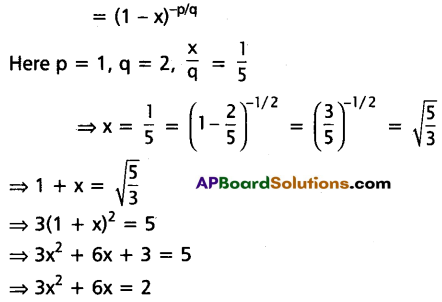
Question 22.
Find the mean deviation from the mean of the following data:
| Marks | 0-10 | 10-20 | 20-30 | 30-40 | 40-50 | 50-60 | 60-70 |
| No. of Students | 6 | 5 | 8 | 15 | 7 | 6 | 3 |
Using step deviation method.
Solution:
Let assumed mean A = 35 then di = \(\frac{x_i-35}{10}\)
Construct the table
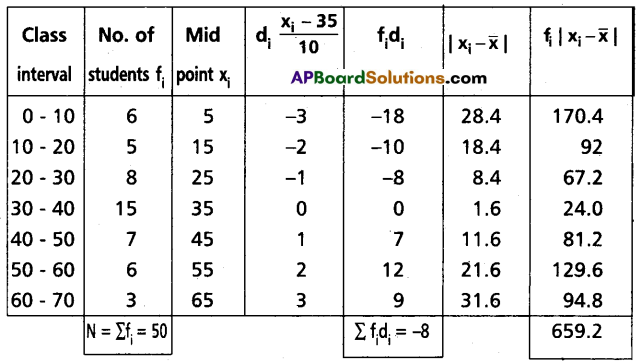
Mean \(\bar{x}=A+\left(\frac{\sum \dot{f}_i d_i}{N}\right) h\)
= 35 + (\(\frac{-8}{50}\)) 10
= 35 – 1.6
= 33.4
∴ Mean deviation from mean = \(\frac{1}{N} \sum f_i\left|x_i-\bar{x}\right|\)
= \(\frac{1}{50}\) (659.2)
= 13.18
Question 23.
Three boxes B1, B2, and B3 contain balls with different colours as shown below:
| White | Black | Red | |
| B1 | 2 | 1 | 2 |
| B2 | 3 | 2 | 4 |
| B3 | 4 | 3 | 2 |
A die is thrown. B1 is chosen if either 1 or 2 turns up. B2 is chosen if either 3 or 4 turns up. B3 is chosen if either 5 or 6 turns up. Having chosen a box in this way, a ball is chosen cit random from this box. If the ball drawn is found to be red, find the probability that it is drawn from box B2.
Solution:
Let E1, E2, and E3 be the event of choosing the box B1, B2, and B3 respectively.
∴ P(E1) = P(E2) = P(E3) = \(\frac{2}{6}=\frac{1}{3}\)
Let R be the event of drawing the red ball from the selected bag.
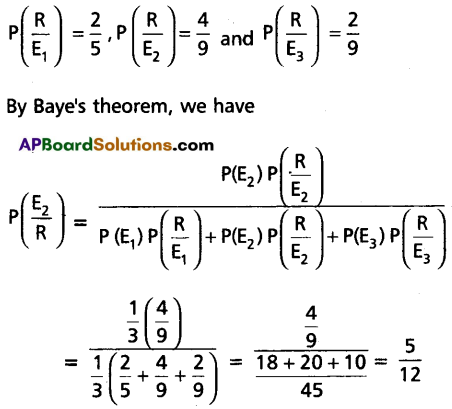
![]()
Question 24.
Two dice are rolled at random. Find the probability distribution of the sum of the numbers on them. Find the mean of the random variable.
Solution:
Let S be the Samili space and X be the random probability distribution of the sum of the two variable numbers on them when two dice are rolled.
Range of a random variable x is {2, 3, 4, 5, 6, 7, 8, 9, 10, 11, 12}

Mean of X = 2 P(X = 2) + 3 P(X = 3) + 4 P(X = 4) + 5(X = 5) + 6 P(X = 6) + 7 P(X = 7) + 8 P(X = 8) + 9 P(X = 9) + 10 P(X = 10) + 11 P(X = 11) + 12 P(X = 12)

= \(\frac{1}{36}\) [2 + 6 + 12 + 20 + 30 + 42 + 40 + 36 + 30 + 22 + 12]
= \(\frac{1}{36}\) [252]
= 7
∴ Mean of X = 7.